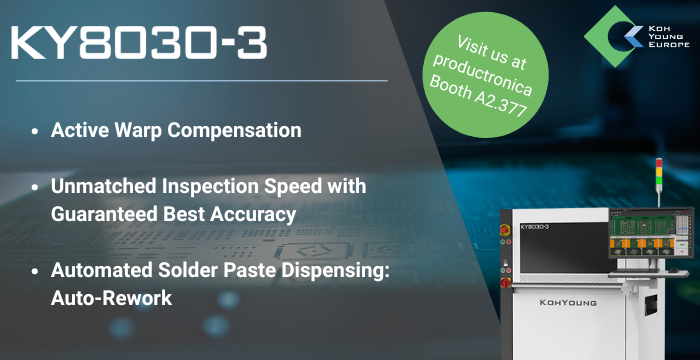
PCB |
RUWEL banks on the future
Now that the investor group Bear Stearns, BlueBay Asset Management and Cargill Value Investment has joined forces with RUWEL, millions are currently being invested in modernizing the main works of RUWEL GmbH in Geldern to meet the continually increasing requirements of pioneering technologies in the electronics field.
RUWEL is the biggest European producer of printed circuit boards for the world´s automotive industry, and automotive electronics account for a good 61% of its € 164m sales revenue. With more than 500 employees, the Geldern plant is almost exclusively focused on this sector.
Laser drilling for automotive applications
The demand for microvia circuit boards for automotive applications is expected to rise sharply in the coming years. RUWEL has therefore now enlarged its microvia capacities at its Geldern high-volume production plant by investing millions in Hitachi equipment for laser drilling technology.
For electronic applications in the motor vehicle, reliability and cost are the measure of all things. Previously, the measure of all things had not been technical feasibility but the most reliable, most cost-effective circuit board design using established standard processes and materials that meet the requirements of the design specification. Quite rightly, the safety awareness of development departments is very highly developed. All that has led to the fact that, to this very day, HDI technology plays a rather subordinate role in the motor vehicle and is focused in the first place on communication applications such as car radios, navigation systems and multimedia. However, there are also users who have long been using microvia technology for safety-relevant areas.
But times have changed. Nearly all innovations in the automobile are connected in some way or other to electronics applications. Electronic equipment is moving into more and more fields (gearboxes, tyres, oil sumps, throttle valve adjustment, accelerator sensors, etc.) that were unthinkable only a few years ago. Added to this come strictly limited installation space, higher temperature requirements, ultra-high packing densities and circuit boards, themselves designed as components (inductors), which more and more necessitate the use of microvia circuit boards.
RUWEL has long been working on the special reliability requirements of electronic equipment for the motor vehicle and works actively with its customers and on projects (e.g. HOTEL) to increase long-term reliability and extend the technological limits in regard to high-Tg applications. This extensive experience and special know-how are now being adapted to microvia technology so as to provide its customers with high-reliability and low-cost microvia circuit boards in quantity lots.
New photoprint shop
Yet microvias make sense only when combined with fine-line structures for miniaturization purposes. For that reason the complete photoprint shop in Geldern will have been re-equipped by next spring and will then be in a position to produce ultrafine-line structures in quantity lots. As a first step the automatic exposure units have now been replaced. This will enable the high-volume production of large-size circuit boards with high topographies having high layer counts and thick copper layers at maximum integration with up to 50 µm fine structures. RUWEL decided in favour of the HAP5020 exposure units from Hakuto, since maximum performance is needed particularly in the qualitatively highly sensitive image transfer area. Together with the Japanese manufacturer Hakuto, RUWEL had more than 15 years ago developed a high-definition exposure system specifically to meet these requirements. Today, RUWEL are using the latest generation - the Hakuto HAP5020 - in their high-volume production shops as the ultra-modern and, with 500 sides per hour.
Fully-automatic AOI for high volumes
Today´s board structures and customer requirements, however, also call for increasingly more complex and more precise inspection procedures under the zero-defects strategy. For that reason, two modern Dragon AOI plants with vacuum-table systems from Camtek have now been purchased and automated for a sum running into millions.
The plants were developed specifically to handle a very high AOI throughput for high-volume production. The Dragon SPs have an improved optical system with optimized sensing of the conductive pattern. This feature combined with new firmware allows reliable detection of any critical defects in the shortest possible time. This precise defect detection system coupled with optimized performance characteristics make the Dragon SP an operationally reliable AOI solution. Accordingly, RUWEL is now in a position to inspect all circuit boards in the Geldern plant to 100% with AOI.
2nd solder resist line
While the above investments served more the dependable production of fine and ultrafine structures and for supporting the zero-defects strategy, other investments are being made to provide greater flexibility in production and to enlarge capacities. Thus, a second automated solder resist coating line will be installed at a cost of more than €1m, and will also enable a second solder resist to be used in parallel.
In the meantime, RUWEL´s machine equipment comprises some 100 machines with more than 500 spindles, and capacity is still not enough. The hole density per circuit board is increasing steadily. Whereas three years ago the average number of holes in RUWEL-typical products was approx. 14,000, this number has now risen to approx. 22,000 (+ 57%), and is expected to rise steadily in the coming years. Yet the trend towards smaller hole diameters is also forcing producers to think about new technologies. Those are the reasons why the pressure is still on to invest in drilling machines.
Drilling machines
RUWEL has now invested in the latest generation of Schmoll drilling machines. Until recently, the hole diameters for RUWEL-typical products ranged between 0.35 mm and 6.5 mm. The requirements to be met for microdrilling have, however, increased tremendously, so that today RUWEL are machining 0.25 mm applications in large quantities and in future will also include 0.2 mm applications.
Schmoll´s SM220 systems operate with speeds from 15,000 RPM to 200.000 RPM. That is the absolute prerequisite to be able to work the required diameter range of 0.2 mm to 6.5 mm productively and with high accuracy. To reduce setup and tooling times, up to 6000 tools can be loaded on Euro magazines in a tool chain. Tooling is carried out while the machine is in operation so the usual downtimes for tooling can be dispensed with.
With these major investments RUWEL has set its sights on the future.
Caption:
High-tech in perfection: Fully automated optical inspection systems for high throughput in the large-volume production of printed circuit boards. MD Ralf Ebeling (left) and interim MD Detlev Schauwecker from AlixPartners (right).




